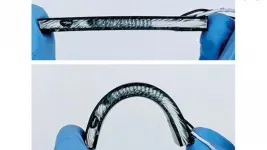Quasars are very bright objects that lie at the centre of some galaxies and are powered by supermassive black holes. As the black hole consumes the surrounding gas, energy is released, allowing astronomers to spot them even when they are very far away.
The newly discovered quasar, nicknamed P172+18, is so distant that light from it has travelled for about 13 billion years to reach us: we see it as it was when the Universe was just around 780 million years old. While more distant quasars have been discovered, this is the first time astronomers have been able to identify the telltale signatures of radio jets in a quasar this early on in the history of the Universe. Only about 10% of quasars -- which astronomers classify as "radio-loud" -- have jets, which shine brightly at radio frequencies [1].
P172+18 is powered by a black hole about 300 million times more massive than our Sun that is consuming gas at a stunning rate. "The black hole is eating up matter very rapidly, growing in mass at one of the highest rates ever observed," explains astronomer Chiara Mazzucchelli, Fellow at ESO in Chile, who led the discovery together with Eduardo Bañados of the Max Planck Institute for Astronomy in Germany.
The astronomers think that there's a link between the rapid growth of supermassive black holes and the powerful radio jets spotted in quasars like P172+18. The jets are thought to be capable of disturbing the gas around the black hole, increasing the rate at which gas falls in. Therefore, studying radio-loud quasars can provide important insights into how black holes in the early Universe grew to their supermassive sizes so quickly after the Big Bang.
"I find it very exciting to discover 'new' black holes for the first time, and to provide one more building block to understand the primordial Universe, where we come from, and ultimately ourselves," says Mazzucchelli.
P172+18 was first recognised as a far-away quasar, after having been previously identified as a radio source, at the Magellan Telescope at Las Campanas Observatory in Chile by Bañados and Mazzucchelli. "As soon as we got the data, we inspected it by eye, and we knew immediately that we had discovered the most distant radio-loud quasar known so far," says Bañados.
However, owing to a short observation time, the team did not have enough data to study the object in detail. A flurry of observations with other telescopes followed, including with the X-shooter instrument on ESO's VLT, which allowed them to dig deeper into the characteristics of this quasar, including determining key properties such as the mass of the black hole and how fast it's eating up matter from its surroundings. Other telescopes that contributed to the study include the National Radio Astronomy Observatory's Very Large Array and the Keck Telescope in the US.
While the team are excited about their discovery, to appear in The Astrophysical Journal, they believe this radio-loud quasar could be the first of many to be found, perhaps at even larger cosmological distances. "This discovery makes me optimistic and I believe -- and hope -- that the distance record will be broken soon," says Bañados.
Observations with facilities such as ALMA, in which ESO is a partner, and with ESO's upcoming Extremely Large Telescope (ELT) could help uncover and study more of these early-Universe objects in detail.
INFORMATION:
Notes
[1] Radio waves that are used in astronomy have frequencies between about 300 MHz and 300 GHz.
More information
This research is presented in the paper "The discovery of a highly accreting, radio-loud quasar at z=6.82" to appear in The Astrophysical Journal.
The team is composed of Eduardo Bañados (Max-Planck-Institut für Astronomie [MPIA], Germany, and The Observatories of the Carnegie Institution for Science, USA), Chiara Mazzucchelli (European Southern Observatory, Chile), Emmanuel Momjian (National Radio Astronomy Observatory [NRAO], USA), Anna-Christina Eilers (MIT Kavli Institute for Astrophysics and Space Research, USA), Feige Wang (Steward Observatory, University of Arizona, USA), Jan-Torge Schindler (MPIA), Thomas Connor (Jet Propulsion Laboratory [JPL], California Institute of Technology, USA), Irham Taufik Andika (MPIA and International Max Planck Research School for Astronomy & Cosmic Physics at the University of Heidelberg, Germany), Aaron J. Barth (Department of Physics and Astronomy, University of California, Irvine, USA), Chris Carilli (NRAO and Astrophysics Group, Cavendish Laboratory, University of Cambridge, UK), Frederick Davies (MPIA), Roberto Decarli (INAF Bologna -- Osservatorio di Astrofisica e Scienza dello Spazio, Italy), Xiaohui Fan (Steward Observatory, University of Arizona, USA), Emanuele Paolo Farina (Max-Planck-Institut für Astrophysik, Germany), Joseph F. Hennawi (Department of Physics, Broida Hall, University of California, Santa Barbara, USA), Antonio Pensabene (Dipartimento di Fisica e Astronomia, Alma Mater Studiorum, Universita di Bologna, Italy and INAF Bologna), Daniel Stern (JPL), Bram P. Venemans (MPIA), Lukas Wenzl (Department of Astronomy, Cornell University, USA and MPIA) and Jinyi Yang (Steward Observatory, University of Arizona, USA).
ESO is the foremost intergovernmental astronomy organisation in Europe and the world's most productive ground-based astronomical observatory by far. It has 16 Member States: Austria, Belgium, the Czech Republic, Denmark, France, Finland, Germany, Ireland, Italy, the Netherlands, Poland, Portugal, Spain, Sweden, Switzerland and the United Kingdom, along with the host state of Chile and with Australia as a Strategic Partner. ESO carries out an ambitious programme focused on the design, construction and operation of powerful ground-based observing facilities enabling astronomers to make important scientific discoveries. ESO also plays a leading role in promoting and organising cooperation in astronomical research. ESO operates three unique world-class observing sites in Chile: La Silla, Paranal and Chajnantor. At Paranal, ESO operates the Very Large Telescope and its world-leading Very Large Telescope Interferometer as well as two survey telescopes, VISTA working in the infrared and the visible-light VLT Survey Telescope. Also at Paranal ESO will host and operate the Cherenkov Telescope Array South, the world's largest and most sensitive gamma-ray observatory. ESO is also a major partner in two facilities on Chajnantor, APEX and ALMA, the largest astronomical project in existence. And on Cerro Armazones, close to Paranal, ESO is building the 39-metre Extremely Large Telescope, the ELT, which will become "the world's biggest eye on the sky".
Links
* Research paper - https://www.eso.org/public/archives/releases/sciencepapers/eso2103/eso2103a.pdf
* Photos of the VLT - http://www.eso.org/public/images/archive/category/paranal/
* More information about the ELT - https://elt.eso.org/
* For scientists: got a story? Pitch your research - https://www.eso.org/sci/publications/announcements/sciann17369.html
Contacts
Chiara Mazzucchelli
European Southern Observatory
Vitacura, Chile
Email: Chiara.Mazzucchelli@eso.org
Eduardo Bañados
Max-Planck-Institut für Astronomie
Heidelberg, Germany
Email: banados@mpia.de
Bárbara Ferreira
ESO Public Information Officer
Garching bei München, Germany
Cell: +49 151 241 664 00
Email: press@eso.org


